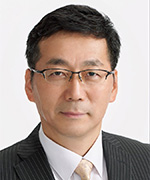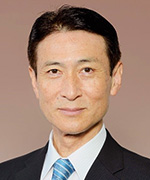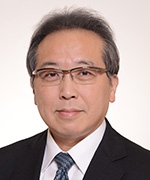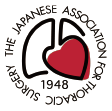Greeting

-
Hirofumi Takemura, M.D., Ph.D.
Congress President, the 77th Annual Scientific Meeting of the Japanese Association for Thoracic Surgery
Professor, Department of Cardiovascular Surgery, Kanazawa University
I am greatly honored to have been appointed as the Congress President of the 77th Annual Scientific Meeting of the Japanese Association for Thoracic Surgery (JATS). The meeting will be held at the Ishikawa Ongakudo, the Hotel Nikko Kanazawa, and the Crowne Plaza – ANA Kanazawa over the three days from Saturday, November 2 to Monday, November 4, 2024.
As the theme of this Annual Scientific Meeting, I have chosen “Singularity – Escape from Inertia.” In astronomy, a “gravitational singularity” is a point at which gravity becomes infinite, and if this exceeds the radius of an astronomical body then the intense gravitational force would compress its material into an infinitely small point, forming a black hole. Recently, however, the term has been more commonly used in the context of the “technological singularity,” referring to the point at which artificial intelligence surpasses human intelligence. “Inertia” can have both positive and negative connotations: in the business world, for example, a long-established company may have been able to continue trading for centuries because it possesses inertia in the good sense, whereas the inertia of a poor corporate culture can be almost impossible to escape. The JATS is a longstanding academic society that was established in 1948 and has the unique feature of covering multiple fields across the three key areas of cardiovascualar surgery, thoracic surgery, and esophageal surgery. However, the particular developments of each of these individual fields mean that a reconsideration of the significance of the existence of the JATS is now a pressing necessity. I thus chose “Singularity” as the theme in the hope that this Annual Scientific Meeting will mark a new development for the three sections of the JATS, and that it will prove to be a “singularity” in the process of moving toward completely independent chairs for the three sections in 2026.
The Thoracic Section will be chaired by Professor Yukitoshi Satoh of the Department of Thoracic Surgery of Kitasato University, and the Esophageal Section by Professor Takashi Kamei of the Department of Gastroenterological Surgery of Tohoku University, and the three of us are working as a tight-knit team to prepare the Annual Scientific Meeting to the best of our abilities.
At the singularity, what will change? This Annual Scientific Meeting has three features. The first is that the numbers of the advanced sessions will be more equally divided between the three fields. This is because we have taken on board the comment that there have usually been more sessions in particular fields or those favored by the Congress President, so that members working in other fields have had less reason to attend. The ratio of advanced sessions will be 26:21:11, with less of a bias compared with the previous ratio of 3:2:1. We are striving to make meeting partication more attractive to JATS members from all three fields. The second feature is that general presentations will not be held at the same time as advanced sessions. This resolves the dilemma previously faced by the chairs and presenters of general presentations, who may have been unable to attend a symposium, panel discussion, or workshop that would have been of value to them. We hope that this will enable more participants to attend the advanced sessions and gain a large amount from them. The third is that we do not want the general presentations to be under-valued. For young JATS members, presenting at such a well-established conference provides valuable experience. We have therefore decided that all general preentations will be oral presentations. This means that presenters must prepare carefully and give their presentations in compact form, giving them an important lesson in summarizing their key points efficiently. I hope to receive an increased number of submissions.
With respect to inertia, the JATS has made great strides in increasing its membership, improving its Annual Scientific Meeting, and pressing ahead with internationalization. As a record of this development, we have published a volume commemorating the 70th anniversary of the JATS. I think that this constitutes inertia in the best sense. However, although the JATS is a long-standing and well-established association, there are some things that we want to change, and some changes that must be made, and it is for this reason that I have chosen the subtitle “Escape from Inertia.” Just how the above three features will provide an escape remains to be seen, but I intend to put together many different creative solutions in the year that remains before the Annual Scientific Meeting in the effort to make this a fruitful conference.
With a view to the internationalization that is one of the missions of thoracic surgery, it has been decided to hold the Mitral Conclave and Thoracic Surgery Symposium of the American Association for Thoracic Surgery (AATS) concurrently in Kanazawa. The fact that many renowned surgeons from other countries will gather and debate here in Kanazawa is the fulfillment of a dream and a great joy. I hope that many JATS member will also take part in the joint sessions with the AATS.
Kanazawa in the first days of November is fanned by a deliciously refreshing breeze. Although the city is said to have the highest number of rainy (or snowy) days in Japan, early November is the height of the fall foliage season in all its vibrant colors. It could give me no greater happiness for as many of you as possible to enjoy the lively discussions at the Annual Scientific Meeting as well as everything Kanazawa has to offer, including the fall foliage and yukitsuri (rope installations to protect trees from heavy snow) of Kenroku-en, Kanazawa Castle Park, and Gyokusen’inmaru Garden, fresh seafood from the Sea of Japan, and the city’s traditional culture. I am looking forward to seeing as many of you as possible in Kanazawa.

-
Yukitoshi Satoh, M.D., Ph.D.
President of the Thoracic Section of the 77th Annual Scientific Meeting of the Japanese Association for Thoracic Surgery
Professor and Chairman, Department of Thoracic Surgery,
Kitasato University School of Medicine
I have been appointed as the President of the Thoracic Section of the 77th Annual Scientific Meeting of the Japanese Association for Thoracic Surgery (JATS). I am conscious that this is a great honor, and would like to express my heartfelt gratitude to all those involved in giving me this opportunity.
I will work together with the Congress President, Prof. Hirofumi Takemura, and the President of the Esophageal Section, Prof. Takashi Kamei, on the preparations to ensure that this will be a meaningful Annual Scientific Meeting.
It is my hope that by engaging in discussions with a view to the future of thoracic surgery and arranging lively cross-disciplinary presentations in line with this year’s theme “Singularity – Escape from Inertia,” we will generate new viewpoints and ways of thinking that would be unattainable at conferences focused solely on individual disciplines. Advanced Sessions in the Thoracic Section will adhere to the existing framework with six categories: “Lung - Neoplasms,” “Lung - Non-Neoplasms,” “Transplantation,” “Mediastinum,” “Chest Wall and Pleura,” and “Surgical Procedures, Minimal Invasiveness, Extended Surgery, and New Techniques.” We are planning attractive symposia, panel discussions, debates, and workshops with a focus on the surgical viewpoint in all these categories. In particular, symposia will be held in the three subcategories of “Lung - Neoplasms,” “Chest Wall and Pleura,” and “Surgical Procedures, Minimal Invasiveness, Extended Surgery, and New Techniques,” entitled “Transitions in Lung Cancer Surgical Procedures,” “Pitfalls in Pleural Mesothelioma Treatment,” and “Approaches Using Novel Techniques for Small Lung Cancers,” respectively.
At this Annual Scientific Meeting, the general oral presentations will be given in Abstract Sessions and Rapid-Fire Sessions that will not be held simultaneously with the advanced sessions but will have their own framework. I anticipate that this will lead to enthusiastic discussions of these general presentations. Because we have put together a schedule incorporating this new initiative, the sessions in the Thoracic Section will take place from Day 1 to Day 3, and will all offer opportunities for meaningful presentations and discussions.
From this 77th Annual Scientific Meeting, we are following the Cardiac Section in officially starting a joint workshop with the American Association for Thoracic Surgery (AATS) during the meeting, which will be something to look forward to.
In conclusion, I would like to express my heartfelt gratitude to the directors of the JATS, the members of the Program Committee, the Secretariat, the staff of the management company, and everyone else involved in the planning and management of the Annual Scientific Meeting. I look forward to meeting you in the historical city of Kanazawa in fall 2024.

-
Takashi Kamei, M.D., Ph.D.
President of the Esophageal Section of the 77th Annual Scientific Meeting of the Japanese Association for Thoracic Surgery
Professor, Department of Gastroenterological Surgery, Tohoku University Graduate School of Medicine
I have been appointed as the President of the Esophageal Section of the 77th Annual Scientific Meeting of the Japanese Association for Thoracic Surgery (JATS). It is both a challenge and a great honor to be given the opportunity to serve as Section President of such a long-standing and well-established conference. I would like to express my gratitude to all the members of the JATS. While assisting the Congress President, Hirofumi Takemura, I shall do my best to make this a meaningful Annual Scientific Meeting in collaboration with Yukitoshi Satoh, President of the Thoracic Section.
Because thoracic surgery deals with vital organs in the chest that are directly linked to the continuation of life, this specialty requires not just extensive knowledge but also high-level skills and control in an environment of constant tension. This Annual Scientific Meeting offers a valuable opportunity to find out not only about scientific developments in the three subfields of cardiac, thoracic, and esophageal surgery, but also to take part in discussions of issues that cut across these fields and to acquire knowledge of other fields.
I am proud to say that we have planned an appealing program of sessions. Advanced sessions in the esophageal field will include both the comparatively new topics of “Robot Surgery Initiatives in Hospitals and Their Results,” “Tips for MIE in Upper Mediastinal Dissection,” and “Indications for Conversion Surgery and Its Limitations,” which is a hot topic amid the dramatic development of multimodal treatment, as well as topics concerning complications and perioperative management, including “Early Diagnosis and Treatment of Suture Failure and Gastric Tube Necrosis After Esophageal Cancer Surgery,” “Attempts to Reduce Perioperative Complications,” and “Staged Surgery (Two-Stage Reconstruction).” In light of the publication of the 12th edition of the Japanese Classification of Esophageal Cancer in 2022, there will also be a presentation on “Verification of the Validity of cStage IIIA.” I also hope that the discussion on the surgery-focused cross-sectional topic of “Dealing with Accessory Injury During Esophageal Cancer Surgery and Conversion to Open Surgery” will attract comments from heart and respiratory surgeons. We have also put together a program for young surgeons aiming to become top esophageal surgeons, including a video seminar on obtaining board certification in endoscopic surgery and a session on how to pass the board certification examination in esophageal surgery. These are all the distillation of wide-ranging comments from the members of the Esophageal Program Committee.
Congress President Hirofumi Takemura has chosen “Singularity” as the main theme of this Annual Scientific Meeting. This term generally refers to the concept of the “technological singularity,” the point at which artificial intelligence (AI) outstrips human intelligence, and the idea that the world will change decisively once AI has gone beyond this point. In other words, I think this theme conveys the intention to position this Annual Scientific Meeting as a turning point, at which many of the issues that have been confronting thoracic surgery are resolved and we can move ahead to the next step. I have great expectations that our lively, future-oriented discussions in Kanazawa will enable us to pass through the Singularity and go on to the next stage. I hope to see as many as possible of you there.



